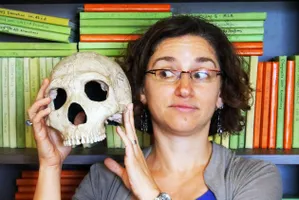NATIONAL MUSEUM OF NATURAL HISTORY
This Thanksgiving, Try the Real Paleo Diet
With Thanksgiving almost here, many people are looking forward to turkey, stuffing, cranberry sauce, and pumpkin pie. But as a scientist who studies what people ate in the deep past - the real paleo diet – I’m bracing myself for the inevitable questions from people who want to know what’s on the menu that qualifies. If, like me, you enjoy the friendly debunking of baseless nutritional lore, here are some conversation starters for this holiday weekend.
/https://tf-cmsv2-smithsonianmag-media.s3.amazonaws.com/blogging/featured/8218985089_6001db5879_k.jpg)
With Thanksgiving almost here, many people are looking forward to turkey, stuffing, cranberry sauce, pumpkin pie…But as a scientist who studies what people ate in the deep past - the real paleo diet – I’m bracing myself for the inevitable questions from people who want to know what’s on the menu that qualifies. If, like me, you enjoy the friendly debunking of baseless nutritional lore, here are some conversation starters for this holiday weekend.
First, some context. I study the evolution of our ancestral diets, particularly focused on the earliest meat-eating. To do that, I look at fossils of animal bones from sites with evidence that early humans and ancient carnivores had eaten them. Early humans leave butchery marks from the stone knives they used to slice meat off of bones and the rounded stones they used to bash open the bones to get at the fat- and calorie-rich marrow; carnivores leave gnawing damage and marks from their teeth. I look at these marks to find out who ate what; who got the juiciest parts of the animals? Did the early humans get there first, perhaps even hunting the herbivores, or did the carnivores munch to their satisfaction and the early humans came in afterwards and get the leftover scraps?
But back to today… one of the main tenets of the modern paleo diet movement is that we (modern humans) haven’t had enough time to evolve the capacity to efficiently and effectively digest certain foods. The focus is usually wheat (or similar grains), but can also include dairy and legumes. To that I say hogwash! There’s good archaeological evidence from residues of a wild relative of sorghum on the edges of stone tools from Mozambique that people have been processing and eating grains for over 100,000 years; plant remains from a site in Israel indicate that people sowed, harvested, and ground wheat, barley, and oats for 23,000 years. Modern populations with high-starch diets have more copies of a gene called AMY1 that causes the production of more salivary amylase (the enzyme in saliva that helps break down starch) than populations with low-starch diets. There’s even recent evidence of similar mutation in domestic dogs facilitating starch digestion dating back between 5,000-7,000 years ago - handy for a species hanging around with humans who were eating more and more starchy foods.
And digesting dairy? That’s one of my favorite examples of fast, recent human evolution. About a third of people on the planet today can digest lactose (milk sugar) after the age of weaning due to persistence of the production of the lactase enzyme. More than 6,500 years ago? Basically none. How do we know? DNA from ancient skeletons. In a geological blink of an eye, at least three independent mutations for lactase persistence arose in populations of people who were domesticating dairy animals in Africa, the Middle East, and Europe (which we know from the archaeological record of the animal fossils and 7,500-8,000 year old pottery in eastern Europe used for making dairy products like yogurt, cheese, or butter). These mutations were strongly selected for; after all, when farmers brought domesticated plants to different environments and their crops sometimes failed in these new habitats, being able to drink a clean source of protein and fat-filled fluid would have come in very handy - and could have meant the difference between surviving and, well... not.
So when you sit down to eat your Thanksgiving meal and one of your dinner companions starts to chew the fat about how the things on the table wouldn’t have been on the paleo diet, now you have a little more to talk about.

